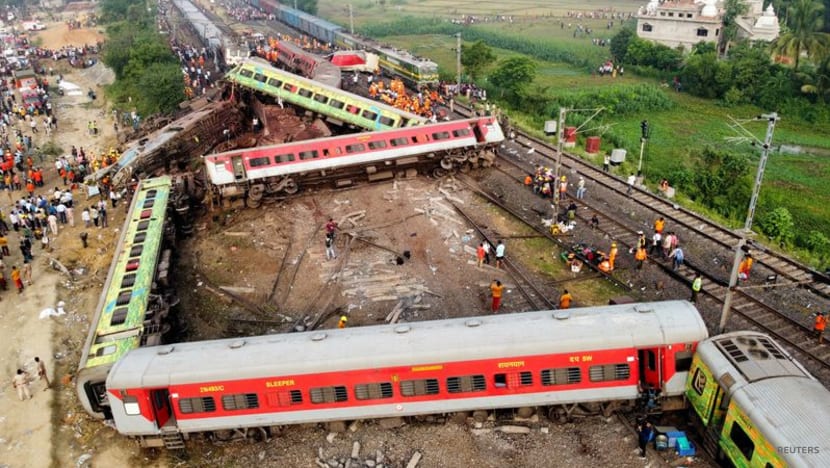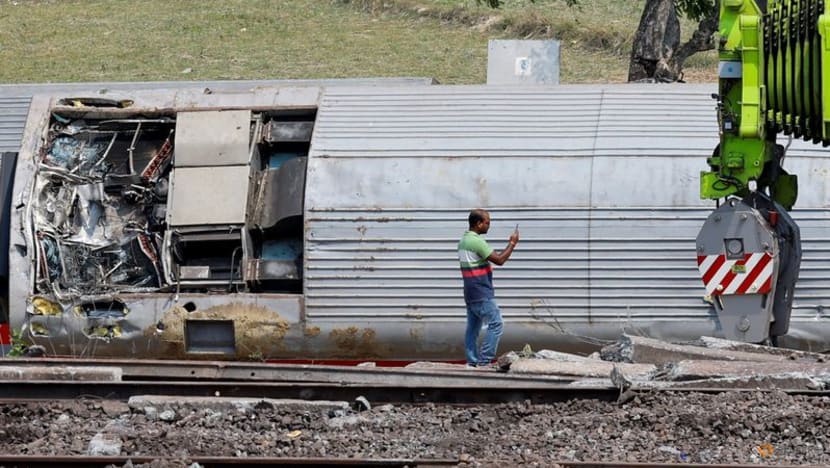India's Central Bureau of Investigation to probe railway crash, with focus on track management system

A drone view shows derailed coaches after two passenger trains collided in Balasore district in the eastern state of Odisha, India on Jun 3, 2023. (Photo: REUTERS/Stringer)
ODISHA, India: India's Railway Board has recommended that the investigation into Friday's (Jun 2) train crash, the deadliest in the country in more than two decades, be handed over to the country's federal investigating agency, Railway Minister Ashwini Vaishnaw said on Sunday.
Rescue workers completed operations on Sunday after the crash, with signal failure emerging as the likely cause of an accident that killed at least 275 people.
Nearly 1,200 people were injured when a passenger train hit a stationary freight train, went off the tracks and hit another passenger train passing in the opposite direction in the eastern state of Odisha, near the district of Balasore.
"For future enquiry, for future investigation, a recommendation has been made by the Railway Board to hand over this case to the Central Bureau of Investigation," Vaishnaw told reporters.
Earlier on Sunday, Indian Railways officials said in their first detailed briefing that failure and suspected malfunctioning of the electronic track management system was the main focus of investigations.
The computer-controlled track management system, called the “interlocking system”, directs a train to an empty track at the point where two tracks meet, Sandeep Mathur, principal executive director for signalling, told reporters.
It also coordinates and controls the signal to an oncoming train, indicating whether the train has to move straight or switch to a new track, he said.
“It is supposed to be tamper-proof, error-proof. It is called a fail-safe system, even if it fails the signal will turn red and the train will be stopped,” said Jaya Varma Sinha, a member of the Railway Board that runs the giant state monopoly.
“However, as it is being suspected, there was some kind of a problem in the system.”


Explaining the sequence of events that led to the crash at Bahanaga station in Balasore district, Sinha said the Coromandel Express heading to Chennai from Kolkata moved out of the main track, entered a loop track – a side track used to park trains – at a speed of 128kmh and crashed into a freight train carrying iron ore that was parked on the loop track.
The crash caused the engine and the first four or five coaches of the Coromandel Express to jump the tracks, topple and hit the last two coaches of the Yeshwantpur-Howrah train heading in the opposite direction on the second main track, she said.
The interlocking system should not have allowed the Coromandel Express to take the loop track, Sinha said.
She said she had spoken to the injured driver of that train and he had told her that he was within the speed limit and had not jumped a signal and all of this would be verified by systems that record track and train details, she said.
She did not name the driver.
There are many “possibilities of what can go wrong”, Sinha said.
This could include someone digging in the area through which cables of the electronic system pass and damaging them in the process, or a short-circuit, or a machine failing.
“99.9 per cent there is no possibility of the machine failing but there is a 0.1 per cent chance of failure,” she said. “That possibility is always there in all kinds of systems.”
She did not name the supplier or manufacturer, or the age of the system - but said it is in use across almost the entire Indian railway network.
The death toll from Friday's crash was revised down from 288 after it was found that some bodies had been counted twice, said Pradeep Jena, chief secretary of the eastern state of Odisha.
More than 900 people had been discharged from hospital while 260 were still being treated, with one patient in critical condition, the Odisha state government said.
State-run Indian Railways, which says it transports more than 13 million people every day, has been working to improve its patchy safety record, blamed on ageing infrastructure.











